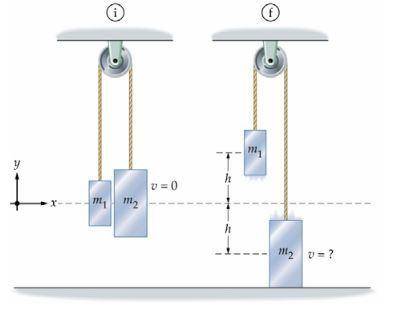
Physics, 08.01.2020 04:31 thefandomarmy24
The two masses in the atwood's machine shown in the figure are initially at rest at the same height. after they are released, the large mass, m2, falls through a height h and hits the floor, and the small mass, m2, rises through a height h.
part a: find the speed of the masses just before m2 lands, giving your answer in terms of m1, m2, g, and h. assume the ropes and pulley have negligible mass and that friction can be ignored.
part b: evaluate your answer to part a for the case h = 1.7 m , m1 = 3.5 kg , and m2 = 4.3 kg.

Answers: 1


Other questions on the subject: Physics

Physics, 21.06.2019 17:10, Naviascales1681
Aseries circuit consists of a resistor with r = 20 ? , a capacitor with c = 0.01 f, and a decaying battery with e = 300e? 5t. if the initial charge is 0, find the charge as a function of time t
Answers: 2

Physics, 22.06.2019 13:50, heatherlemaster
The magnitude of the poynting vector of a planar electromagnetic wave has an average value of 0.939 w/m^2 . the wave is incident upon a rectangular area, 1.5 m by 2.0 m, at right angles. how much total electromagnetic energy falls on the area during 1.0 minute?
Answers: 2

Physics, 22.06.2019 14:50, MoogleCaliS
Nitrogen (n2) undergoes an internally reversible process from 6 bar, 247°c during which pν1.2 = constant. the initial volume is 0.1 m3 and the work for the process is 121.14 kj. assuming ideal gas behavior, and neglecting kinetic and potential energy effects, determine heat transfer, in kj, and the entropy change, in kj/s. show the process on a t-s diagram.
Answers: 2

Physics, 22.06.2019 21:20, payshencec21
People with normal vision cannot focus their eyes underwater if they aren't wearing a face mask or goggles and there is water in contact with their eyes. in a simplified model of the human eye, the aqueous and vitreous humors and the lens all have a refractive index of 1.40, and all the refraction occurs at the cornea, whose vertex is 2.60 cm from the retina. with the simplified model of the eye, what corrective lens (specified by focal length as measured in air) would be needed to enable a person underwater to focus an infinitely distant object? (be careful-the focal length of a lens underwater is not the same as in air! assume that the corrective lens has a refractive index of 1.62 and that the lens is used in eyeglasses, not goggles, so there is water on both sides of the lens. assume that the eyeglasses are 2.05cm in front of the eye.)
Answers: 3
You know the right answer?
The two masses in the atwood's machine shown in the figure are initially at rest at the same height....
Questions in other subjects:

Mathematics, 05.11.2020 06:50

English, 05.11.2020 06:50

English, 05.11.2020 06:50



Mathematics, 05.11.2020 06:50

Mathematics, 05.11.2020 06:50


Mathematics, 05.11.2020 06:50

Computers and Technology, 05.11.2020 06:50











